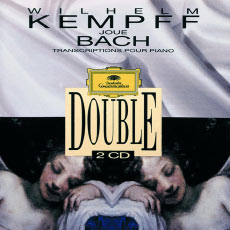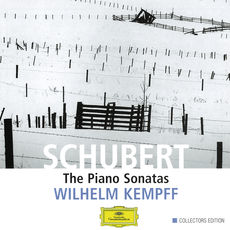An artist of another time, Wilhelm Kempff (1895-1991) believed in inspiration: he took on music as if it were a religion, with a respectful enthusiasm for the masters that came before him. With his velvet touch, sense of phrasing and storytelling quality, Wilhelm Kepff’s art was like that of a waking dream. Half poet, half divine, during a time when expression of emotion triumphed all. He recorded many times the works of his favourite composers, in particular his ‘god’ Beethoven, for whom Kempff is well known and left behind three complete sonatas in keeping with his own maturation and the evolution of his recording technique.
The son of a composer and the nominated organist of Saint-Nicolas church in Potsdam, Wilhelm Kempff grew up surrounded by music, a language he understood before he could even speak. In his youth memoirs, published in France (for Plon) in 1955 under the title Cette Note Grave (The Low Note), Kempff writes, with a literary flair and style that is tantalisingly old-fashioned, of how his devotion to music was combined with his Lutheran father’s religion. The family only ever spoke of music and practiced it as naturally as breathing. An organist himself, Kempff would remember all his life how “the low note” from the organ would wake up the little child to the world of music. It was under the kindness of his father and luminous smile of his mother that the young boy would begin to learn the organ and the piano before attaining two bursaries that would allow him to enter at the age of nine into the Hochshule für Musik Berlin. At the end of the First World War he performed as a soloist in Beethoven’s Concerto no.4 with the Philharmonic Orchestra of Berlin under the direction of its head, the legendary Arthur Nikisch. At 24 years old, the young Wilhelm Kempff was well prepared to undertake one of the most glistening musical careers of the 20th century.
Johann Sebastian Bach is without a doubt an important figure in every Lutheran family that is the slightest bit musical. Among the Kempff family, preludes, fugues and chorales were everyday items from father to son. It is therefore natural that the composer would accompany Wilhelm throughout his life, from organist to pianist. At the very end of his career, his closed the loop by recording preludes and chorales (often his own transcriptions), suites and Goldberg Variations which were not common at the time. Without edit or retakes, Kempff’s recording technique is stripped down, even austere although tinted with a certain romanticism. In 1980, he made his last recording with extracts from a well-tempered keyboard.
Beethoven: a companion for life
“Look”, said my father, “here you have the heavier notes, the ones that last a long time; and here are the lighter notes that make but the slightest vibrations in the air. Do you know who invented these?”, he asked me with a solemn gravity.
I thought he was going to say God.
But he said Beethoven.
I must admit that I was overwhelmed by this response. It was the first time that I had heard this name, and it came from the mouth of my dearest father. His words aroused feelings within me that overwhelmed. I wept uncontrollably."
(Wilhelm Kempff in Cette Note Grave)
As you can see, Wilhelm Kempff’s love for Beethoven stirred up his first emotional response to music. In fact, Kempff became one of his best interpreters and played him incessantly, adding to his earliest recordings from the 1920s consistently until the end of his life. He continuously performed collections all over the world, such as in Tokyo in 1961, that were meticulously recorded and available today on your Qobuz. The temperance of his playing and the interiority of his way with song puts him at the forefront. After playing the sonata Hammerklavier in 1920 in front of Sibelius in Finland, the composer said to him: “You haven’t played like a pianist, but a human being.” Not a small compliment for someone as withdrawn as the Finnish composer.
It’s never easy for an honest music lover to find themselves in a jungle of 32 recordings of sonatas, with three integral works recorded in studio, of which one is incomplete, and the numerous isolated sonatas taken from concerts and radio demos, without even mentioning his work in Japan which is held in very high regard. While the two official versions recorded by DG are both of merit, some prefer the first version for its monophony in which the pianist’s fingers are more agile. Others choose the last in stereophony as it represents his final Beethovenian vision.
The choice is similarly Cornelian for his 5 concertos of two “official” takes with the Philharmonic Orchestra of Berlin, firstly in 1953 under the direction of Paul van Kempen, then in 1962 with Ferdinand Leitner. For us, it is the 1953 version that reigns supreme with its fast tempo and musical discourse that is maintained from start to end by the soloist and conductor.
In 1970, DG published the complete works of Beethoven to celebrate the bicentennial birthday of the conductor with thunderous effect as it was the first publication of its kind. In this recording, we can find the concertos and sonatas of this “household” pianist, but he was also asked to record for this edition the Sonatas, on violin and piano with a rather musically weakened Yehudi Menuhin, and the Trios with piano with Henry Szeryng and Pierre Fournier. With regard to sonatas for cello and piano, DG published a beautiful concert version, recorded in 1965 in the Salle Pleyel of Paris with his partner in crime and friend Pierre Fournier, along with some retouching in the studio.
Create a free account to keep reading









